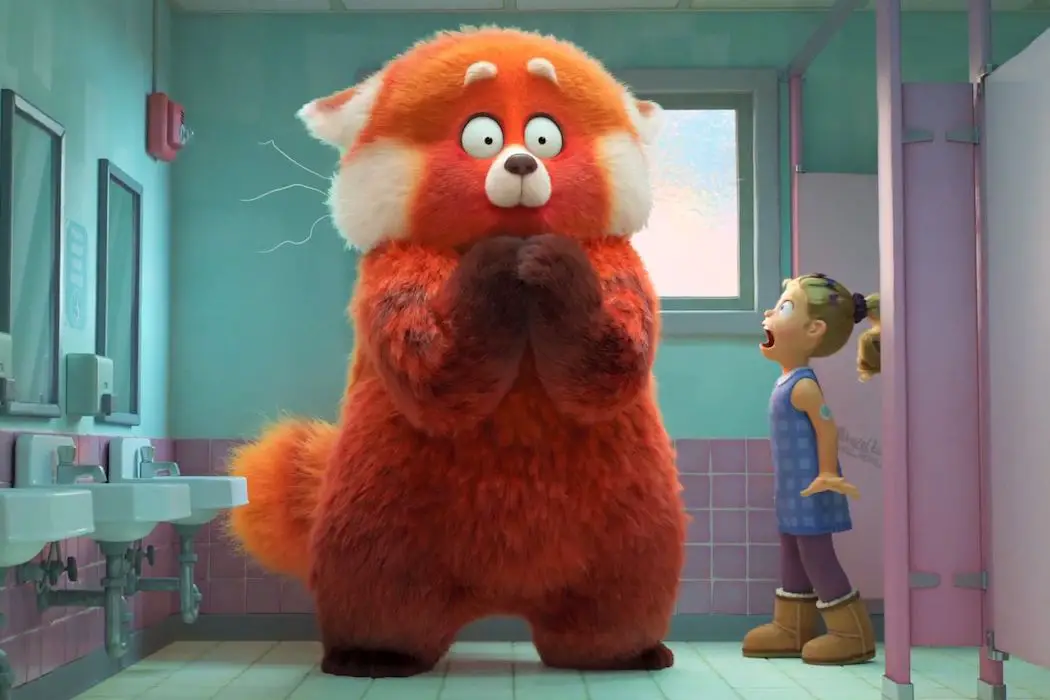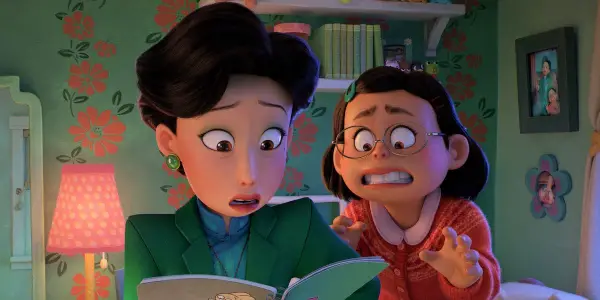TURNING RED: A Big Fluffy Silly Ball of Energy and Heart

Kevin L. Lee is an Asian-American critic, producer, screenwriter and…
Step aside Clifford, because the red panda is the superior animal that’s big and red. Turning Red is a milestone for Pixar in many ways. For starters, it’s the first film to fully take place in Canada, and the first film to feature an Asian protagonist. But most of all, it’s the first film from the studio to be solely directed by a woman. With Pixar’s problematic production behind Brave, a lot was riding on writer/director Domee Shi to deliver on a personal story with as much creative freedom as possible. The result is a heartwarming treat for the whole family that I so wish could play in the theater, because Turning Red is a total blast.
An Incredibly Relatable Lead
The key lies in Mei Lee (Rosalie Chiang), an energetic, hard-working Asian girl who lives a happy social life. One catch: her lifestyle still revolves around helping, listening to, and “serving” her mother Ming (Sandra Oh). It’s not a big deal though. It’s never really been a big deal for Mei. But with her turning 13 and about to enter high school, Mei is learning to think for herself and is realizing she is not the person her mom wants her to become. With that comes newfound stress and anxiety… and a startling revelation that when she gets too excited, she turns into a giant red panda.
Though this premise of fantastical transformation is not new in family films, nor is the premise of coming-of-age and dealing with tensions between parent and child, Turning Red efficiently cuts through that familiarity and dives straight into Mei’s panda lifestyle. With the reactions of her friends and classmates all being “How adorable,” the script skips past a lot of cliches and been-there-done-that tropes.

It also helps tremendously when your protagonist is already so outspoken and confident in her interests, hobbies, and celebrity crushes. This is someone who definitely knows who they are. The conflict – and thus the heart of the story – comes when they also feel like they need to preserve an image for their parents. The beautiful part is the act is not entirely done out of fear, but rather of love and wanting to keep the peace. It’s an astoundingly relatable headspace, particularly for this Asian American critic.
A Brilliant Clash of Wants and Needs
With Mei discovering her bizarre situation, an average animated film would spend a lot of Act 2 on Mei learning how to “control the panda.” So what if we just took that story beat and covered it within a few minutes? This is where Shi flexes as a storyteller – she understands that the panda may be the cute attractive thing that gets you to watch the film, but it’s nowhere close to what the film is really about. What is far more interesting is how Mei and Ming respond. Naturally, they both want a solution to get rid of the panda. But with the script quickly solving that issue of “control,” it frees up a lot of space for Mei to change her desires over the course of the film. Ming, however, remains the same. That’s how she’s lived her life, and as the story progresses, we come to understand how and why she is how she is as a mother.
But like a lot of real parents, Ming doesn’t understand that half of her good deeds and intentions no longer align with Mei’s desires and interests. It’s not a matter of Mei becoming a teenage rebel who openly opposes parental authority. Instead, Turning Red goes for the simplest, yet more nuanced approach: Mei’s just growing up and is not a child anymore, and Ming’s not seeing it. Or better, she’s finding it hard to accept, because one of the hardest things for a parent to do is to let go of your child and let them be. But it’s so easy to forget that that insecurity in a parent comes from deep, immeasurable love for the child.
Poppy Animation, Silly Shenanigans
The emotional depth here is more than enough to hold the film’s style and set pieces, because that’s another strength in Turning Red – boy is this film silly and it knows it! With beautiful colors, animation that pops, and exaggerated facial expressions that bring back fond memories of Studio Ghibli films, Turning Red proudly waves its personality flag, and it’s not apologizing for any of it. More films with this kind of energy, please!

Chiang and Oh both bring such a wide range of emotions to every scene, from the wacky to the nurturing to the meaningful. Accompanying them is a rather enormous supporting cast of characters, a standout being Mei’s quiet but insightful dad (Orion Lee). But most of all, we can’t forget Mei’s friends – Miriam (Ava Morse), Priya (Maitreyi Ramakrishnan), and Abby (Hyein Park) – who all share the same undying love for a boy band called 4*Town. It’s a fictional band but the Backstreet Boys and NSYNC vibes are uncanny.
From start to finish, these characters go through a ton of wild, middle-school shenanigans that may seem familiar and not entirely original, but it’s the personality that shines through. Without a doubt, a lot of young viewers, especially those of color, will see themselves in at least one character.
Turning Red: A Colorful Delight with So Much Heart
It’s incredible how 25 films in, Pixar can still bring a creative team together and find a new angle and perspective to tell a universal story of growth. What’s even more exciting and moving is that the studio has recently been embracing simpler stories. With the two best Pixar titles in recent years being Luca and now Turning Red, it is clear that there are still plenty of new and original voices out there waiting to share their stories.
The lasting strength of Turning Red does not come from the plot or premise originality. It’s all in the telling. Domee Shi could’ve just made a short film about a mother grieving over their child leaving home for the first time. She *could’ve* done that. Or she could choose to do all that and wrap a cute, memorable steamed bun metaphor around it all. She accomplished that with the Oscar-winning Bao, but it’s clear – at least to this critic – that Turning Red is the bigger, more rounded and complete story she wanted to tell. Frankly, the red panda triumphs.
What did you think of Turning Red? Let us know in the comments below!
Turning Red will be released on Disney+ on March 11, 2022.
Watch Turning Red
Does content like this matter to you?
Become a Member and support film journalism. Unlock access to all of Film Inquiry`s great articles. Join a community of like-minded readers who are passionate about cinema - get access to our private members Network, give back to independent filmmakers, and more.
Kevin L. Lee is an Asian-American critic, producer, screenwriter and director based in New York City. A champion of the creative process, Kevin has consulted, written, and produced several short films from development to principal photography to festival premiere. He has over 10 years of marketing and writing experience in film criticism and journalism, ranging from blockbusters to foreign indie films, and has developed a reputation of being “an omnivore of cinema.” He recently finished his MFA in film producing at Columbia University and is currently working in film and TV development for production companies.













